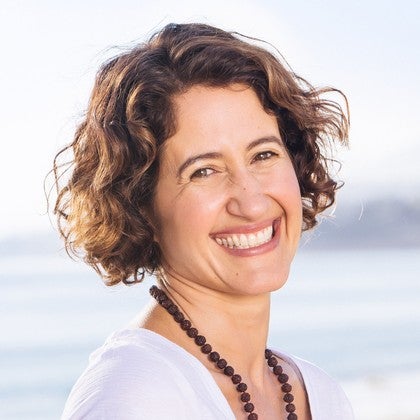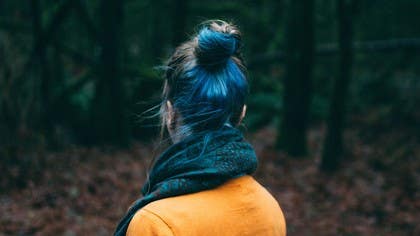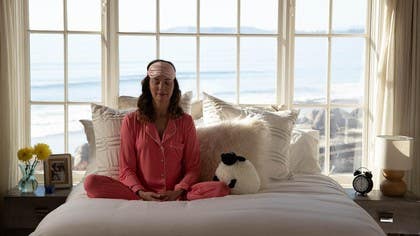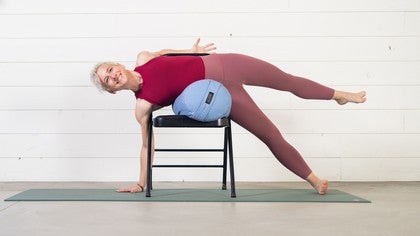
Family AcroYoga and Real Life
Deven Sisler and I sat down together in a Zoom room late on Friday night after her toddler was asleep. We talked about Family AcroYoga, play, trust, collective listening, and spontaneous personal prayer.
Deven came to AcroYoga from circus acrobatics where the guiding philosophy was that if a trick doesn't work, just do it again, and again, and again. There was no concern for safety, and injury was accepted as normal. What she discovered in AcroYoga, and keeps discovering, is a safe container in which play is the access point into a quality of communication that leads one to the present moment.
Questions and answers are edited a bit to transform a conversation between friends into written language. Deven’s answers were so beautiful, complex, and multi layered that at times I insert questions to help organize her magnificent stream of consciousness.
[Yoga Anytime]: What is Family Acro Yoga?
[Deven Sisler]: Family AcroYoga can be a lot of things. It can be cute and relaxing and messy, and for me it’s just real life. We’re all just in it. If I need to be doing meditation and yoga alone, and I compartmentalize that away from my family and my child, it may not get done in the schedule.
We can easily become human jungle gyms. When I'm doing my personal practice, my son will climb up on my back. We’ll do a little bit of acro yoga and play, and then he’ll go back to entertaining himself. We’re not separate; we’re all mashed together.
[YA]: What does personal self care look like in your house right now?
[DS]: We foam roll more than we used to. Self massage is something that has become more important. And meditation and breathing techniques are the things I need to do.
[YA]: Let’s talk more about play and its central role in AcroYoga.
[DS]: One of the things at the root of Family Acro Yoga is laughter. If you are laughing, you are doing it right.
We have this idea of what yoga can look like: The clean studio space, the quiet, no devices, the teacher takes you through the thing and all the students listen.
In a ‘Baby and Me’ class, some people might be crying, some people might be yelling, some people might need to eat, and some people might need to poop. So that’s what life looks like. That’s what families are like.
Yoga is not in it’s own little box. When can we open up that box and know we are in life all together. If we are laughing, we are accessing breath. We're releasing tension together, and we are sharing a little bit of joy.
[YA]: Tell us why this kind of practice is so important right now.
[DS]: Right now what we are experiencing is a collective trauma, a global collective trauma we have no cultural memory of happening. The Spanish Influenza of 1918 was the last similar thing, and anyone that lived through that was so little, so young, they don’t really know what was going on after that period of WWI.
We don’t know how to deal with this, all we can do is try to protect our little pods that we are in.
And so when we can access any play, any laughter, any of that present connection in crazy this moment, then later on we can say, “I was safe, I was okay, everything was fine.”
[YA]: How does your toddler help you notice the present moment?
[DS]: My child is a great example. He doesn’t care if the house is clean, or my to do list. I am holding on by a string of normality by my to do list.
We’re growing some vegetables right now and nurturing them every day. He loves helping me, and he also loves dunking his boots. Inevitably the gardening is going to devolve into some sort of play and we both do better if I just let him lead us both into that moment.
[YA]: Remind us how you came to AcroYoga.
[DS]: I came to AcroYoga from acrobatics in the circus world. The philosophy there was, “If it doesn't work, just try it again, and again and again.” We did not always work with spotters or compassionate communication. So I did not always feel safe, and I would get hurt for weeks at a time.
There is a big difference between being physically able to do something and being mentally and emotionally ready to do something. This is where I come back to non-violent communication, compassionate communication, collaborative listening, and checking in.
One of the biggest foundations of the practice as a teacher is to offer little things to try and see how it goes. Within the circle of the base, flyer, and spotter, it’s essential to keep checking in and hold the space for what actually feels good. If someone in [that circle] doesn’t want to do something, let that person pick the activity they want to do.
Within a classroom setting, this requires a teacher to give up the role of absolute authority and allow the trust to collectively rise and respect to spread through all of us.
[YA]: Please define the roles of base, fyler, and spotter for us.
[DS]: The base is the realist, the flyer is the optimist, and the spotter gets to be the pessimist.
The base is closest or attached to the earth. The flyer is the person who is in the air being supported. The spotter is looking for what might go wrong and how they can safely gently bring the flyers feet back to the ground.
One of the unique components in Family AcroYoga, is that we want all the adults to try base, spotter and flyer. You know that saying, “If you want to fast, go alone, if you want to go far, go together.”
When we can be in the collaborative listening, and attune to where we are as a group, and know when and where we are ready to move (physically, emotionally and mentally), we all get to learn a lot of different things, and all play all the different roles. Everybody gets to fly, base and spot.
When I can support my 6’5 200 pound husband in doing stuff, then I know that I am stronger and we begin to cycle through that trust and respect. So it’s fun when we are in that place, trying to get a workout in, but we are also laughing.
[YA]: What are some of the main benefits of Family AcroYoga?
[DS]: One of the greatest benefits is a changing up of our usual roles. When parents can be vulnerable and receive support and kids can feel like they are giving care and providing stability, all sorts of things become possible.
And of course, there is play. Everybody needs that, especially right now. There's the possibility to access joy and laughter. And we are getting stronger, physically, mentally and emotionally.
We are not only developing our physical muscles, we are also developing our trust muscles, and learning how to squeeze those. We’re learning how to do something when we’re just a little on our edge. We’re learning how to be in connection.
And you can't be doing AcroYoga and also scrolling on your device part of the time. AcroYoga requires eye contact, focus, and clear communication.
And, it’s great for social emotional learning.
[YA]: Define Social Emotional Learning for us.
[DS]: As parents, we model all the time. For me that means I am telling you how I am feeling and what I need. I am not listening for the answer that I want, I am actually listening to what you are saying.
As a parent new to AcroYoga, if I am on my edge of learning, I am modeling how I deal with being out of my comfort zone. If I honor and respect the feelings and emotions of myself and my child, then I encourage them to trust their feelings and feel safe in communicating them.
The parent has to put themselves in place of learning a new skill in community. We can show up in a way that is responsive, vulnerable, and accepting instead of defensive. We can let go of being experts as adults and the kids get to see what it looks like when their parents are learning and that it’s okay.
Knowing how to be on the edge as a team is a great skill.
[YA]: Will Family AcroYoga help my family communicate better?
[DS]: Family AcroYoga can help you unwind and find new communication patterns, but if you have a lot of stress and a lot of things compounding each other, it might exacerbate some of your communication issues you already have.
If you are making time for Family AcroYoga, it's a great opportunity to not take anything personally. Just let it be what it is. We’re not gonna tell a child, “you're playing wrong.” Don’t make Family AcroYoga another thing on your to do list to do right.
Sometimes it's just better to put on music and have a dance party and get the wiggles out. Sensing when the energy is low and reading a book might be a better option is key. Knowing when to change the channel is a great skill.
[YA]: How do we prepare our homes to be safe for AcroYoga?
I like Puzzle Mats instead of yoga mats. The thicker you get the foam, the harder it is to base. The more flat , the more solid the surface. Go out in the grass if it’s warm enough. And couch cushions are really nice thing to have around.Part of the job of the spotter is to look at the zone you are in and make it safe for any unplanned landings.
[YA]: How can we prepare our bodies for family acro yoga?
[DS]: A few good sun salutations to get warmed up. Hip openers like Lizard Pose, Half Happy Baby, Low Lunge. I really like doing one side and then the other side. Make sure everything's loosened up and warm. And handstands at the wall are a nice way to prepare to support someone else.
[YA]: How do we prepare mentally and emotionally?
[DS]: I like to play a lot of games. A great resource is Mindful Games, by Susan Kaiser Greenland.
One of the things you might want to do as a family is a super slow motion sun salutation. So you're not thinking we're gonna jump into things and hurl our bodies into space.
Checking in with each other is essential.
We use American Sign Language communication techniques with our toddler. Deven demonstrated a circular thumbs up motion as her method of communication that she’s okay and a chopping motion to indicate that it’s time to stop.
[YA]: Who can do Family Acro Yoga?
[DS]: Everybody! If you are running around after your children, you’re ready. If you can do yoga, you can do Family AcroYoga. Or if you want to be riding bikes, hiking, playing at the beach, than it’s for you.
[YA]: Are kids or adults are more naturals?
[DS]: Kids can be hesitant, but they bring the excitement once you get past the front door. Adults often bring baggage and preconceived notions. But as soon as they can step through that, the family can mix up what their roles are.
I have had children base their parents, and kids love giving their parents leg love at the end of class.
[YA]: Anything else you want to share?
[DS]: Don’t think past the next 2 weeks if possible. Be easier on yourself. Start a meditation or prayer practice. It will help a lot. And connect with your kids. That’s what they will remember most about this time.
Check out Deven's Family Acro Yoga Show. You can also practice live with Deven most Friday mornings at 9:00 PDT (Oregon Time) for Pajama Yoga via her Facebook Page. As she puts it, “There might be a dog, a kid, a husband. It’s messy.”
Comments
No comments yet. Be the first!












You need to be a subscriber to post a comment.
Please Log In or Create an Account to start your free trial.